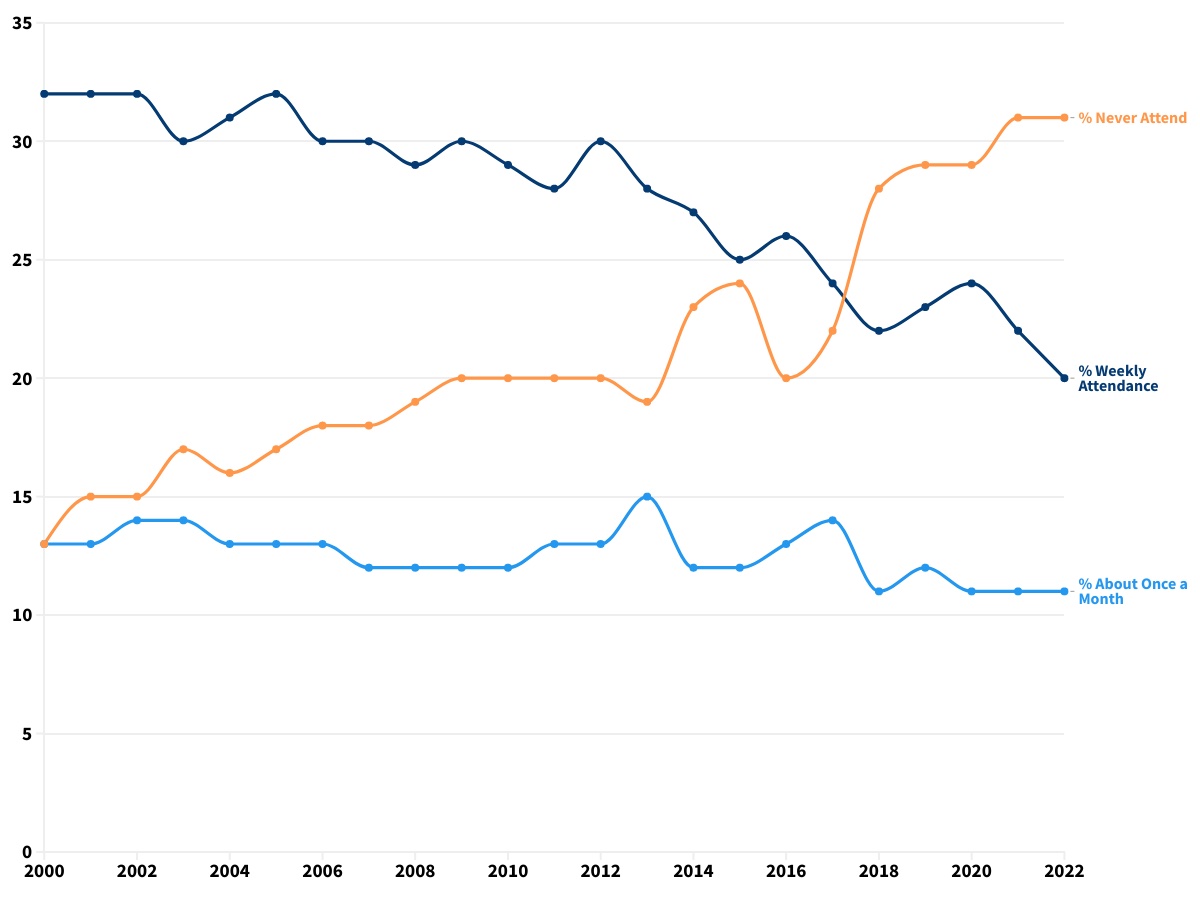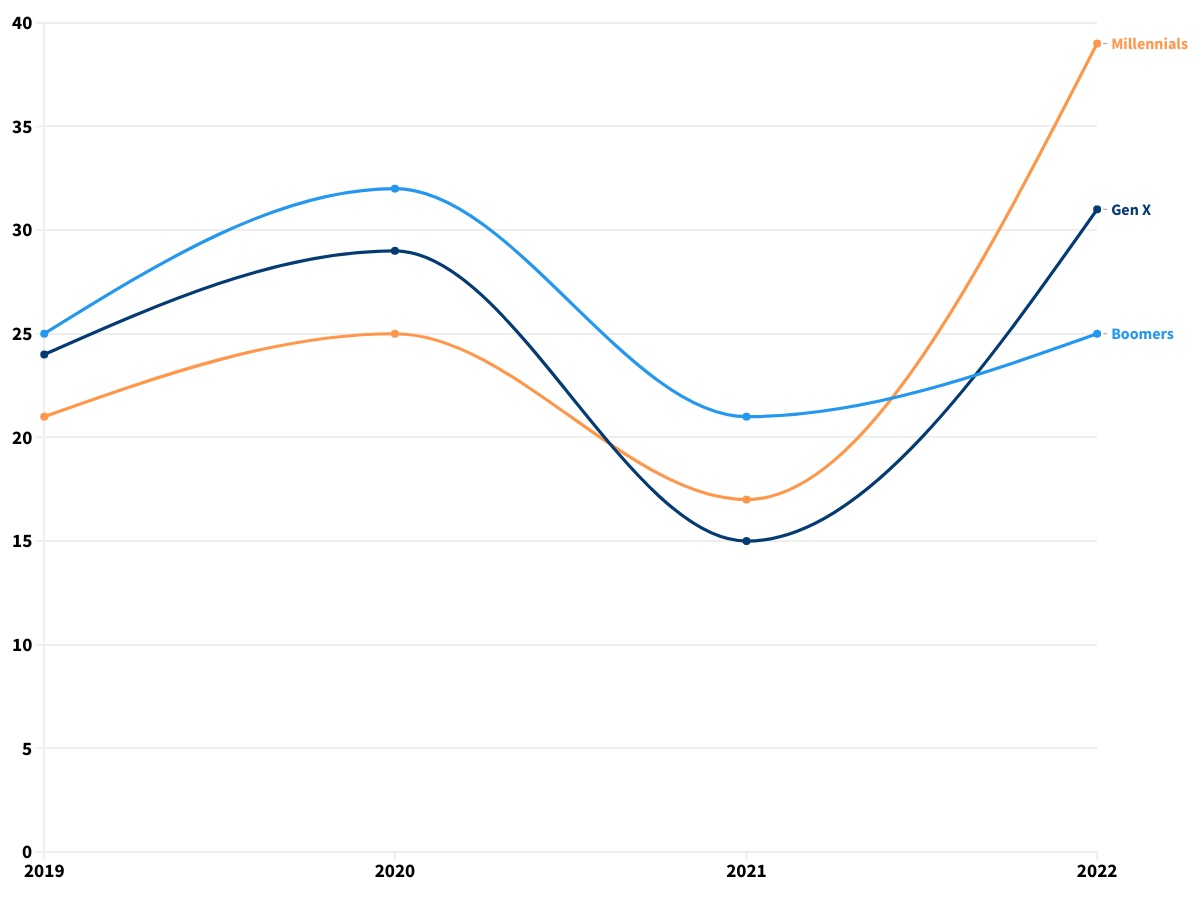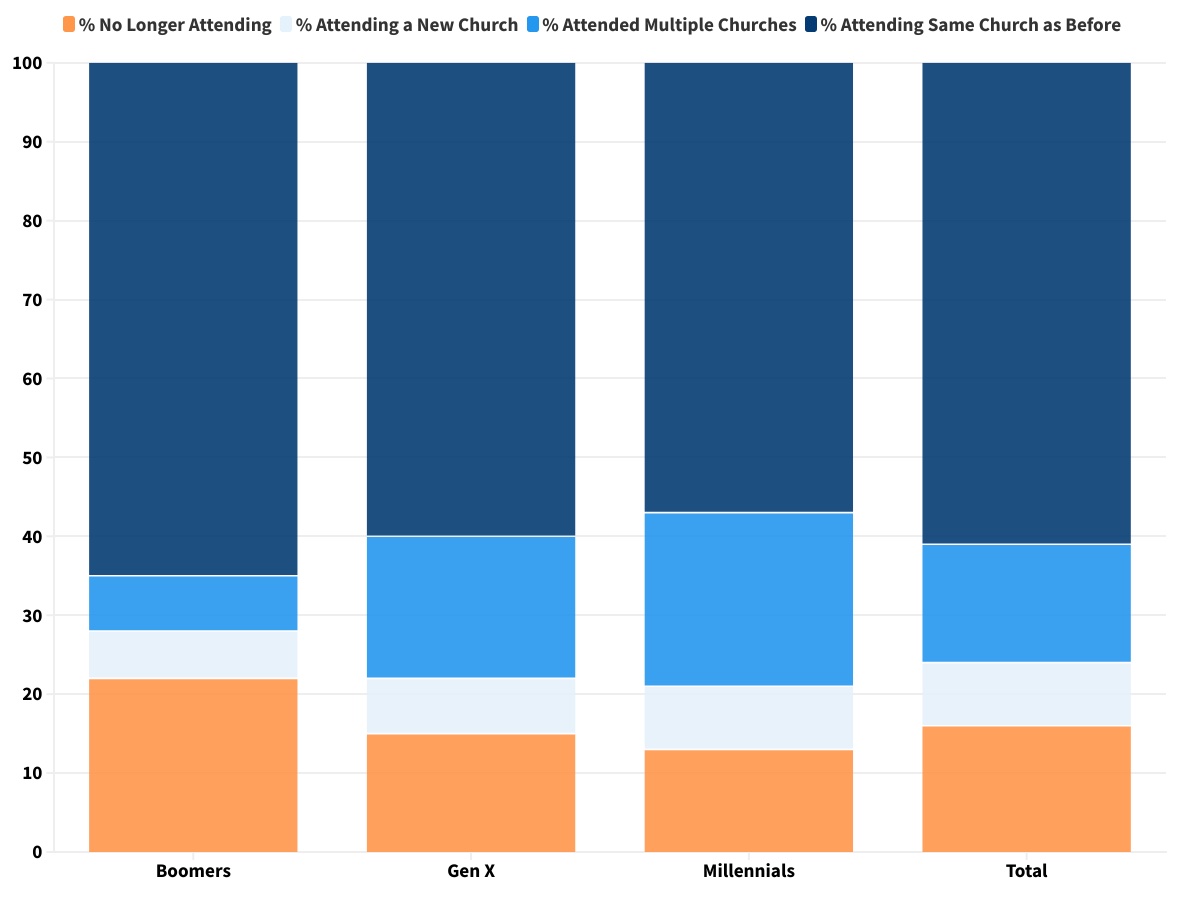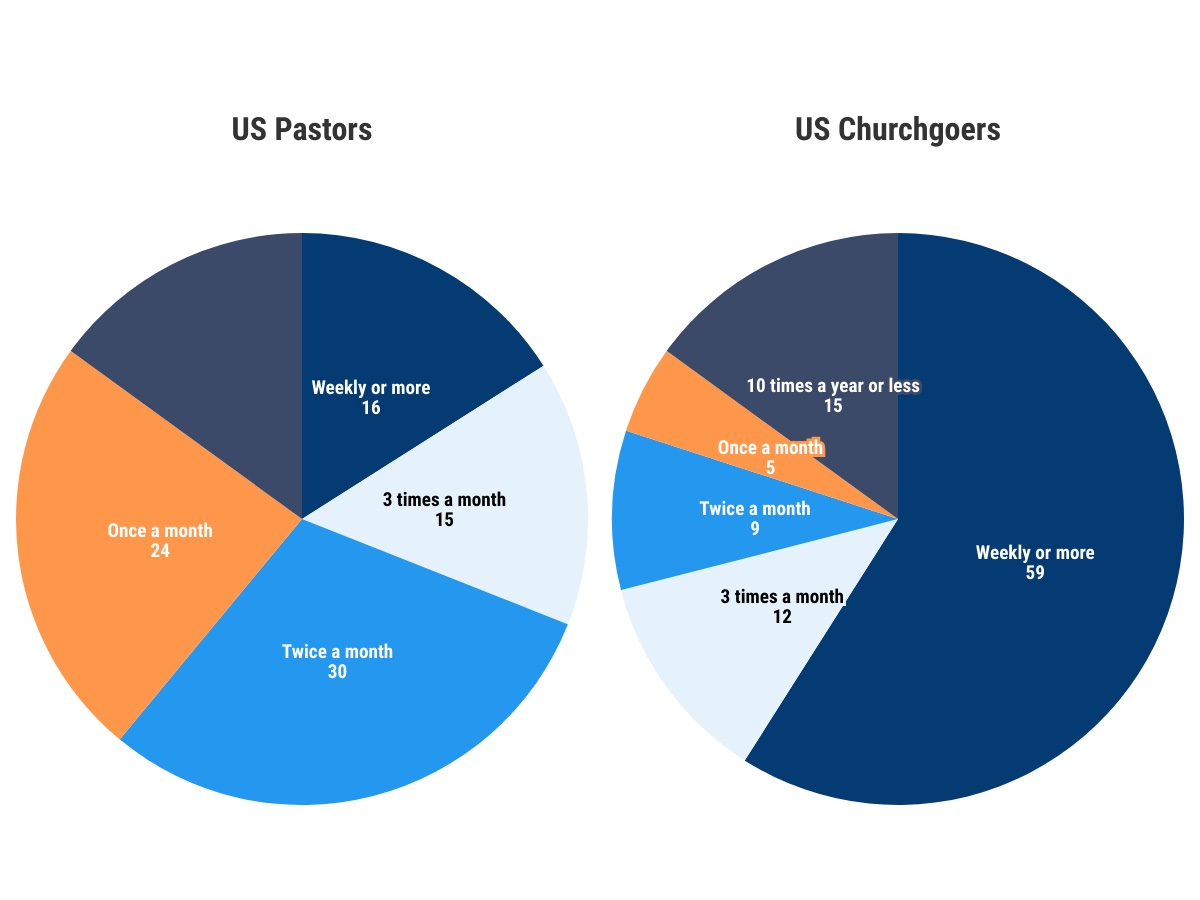The State of Church Attendance: Trends and Statistics [2025]

Here are the most important (and sometimes surprising) church attendance statistics you need to know as you lead and manage your ministry in 2025.
What Percent of Church Members Attend Regularly
There has been a significant decline in church attendance since the turn of the 21st century, according to multiple surveys of church attendance from several research institutions. The chart below made with data from Gallup's recent survey illustrates the trend:

What percentage of churchgoing people attend regularly depends on your threshold for what you consider regular attendance. If once a week, only 20% of Americans attend church at that rate, down from 32% in 2000. If we lower the threshold to once a month or more, the number of Americans in regular attendance jumps to 41% (this combines all respondents who answered weekly, almost every week, and about once a month in the Gallup survey).
Key Statistics:
- 20% of Americans attend church every week (Gallup)
- 41% of Americans are in monthly church attendance or more (Gallup)
- 57% of Americans are seldom or never in religious service attendance (Gallup)
- Regular church attendance has steadily declined since the turn of the century (Gallup and Pew Research Center)
What Percent of Millennials Attend Religious Services
39% of Millennials report attending church on a weekly basis, according to Barna's recent State of the Church report. This is a significant increase over years prior and places them at a much higher rate of attendance than Generation X and even the Boomer generation, which had previously been more faithfully in attendance than their younger counterparts.

Though most churches are still below pre-pandemic attendance rates, many church leaders are seeing a return of past members, as well as an increase in guests. Read our article on Getting Your Church to Come Back in 2023 to learn how you can reach past members and see growth in the year ahead.
Key Statistics:
- 39% of Millennials report attending church weekly, up from 21% in 2019 (Barna)
- Non-white Millennials drive the increase in church attendance. 45% of non-white Millennials are attending church weekly, compared to 35% of white Millennials. (Barna)
Why Are Millennials Leaving the Church
Many Millennials never had strong ties to religion in the first place. My generation was not brought up in the church in the same numbers as generations prior, leaving us without much connection to the church as we entered adulthood.
Millennials are also reportedly turned off by the high-profile church leadership scandals and the increasing political polarization in many American congregations, causing many to lose trust in churches and religious institutions altogether.
Hopeful Signs of Millennial Church Attendance
However, there are some hopeful signs. Millennials make up the largest surge in returns to church as the pandemic has ended. We are entering crucial life stages that make us open to church as a way to connect and find guidance.
Key Statistics:
- 39% of Millennials report attending church weekly, up from 21% in 2019 (Barna)
- 40% of Millennials are religiously unaffiliated (Pew Research Center)
Which Churches Are Losing the Most Members
For decades, mainline protestant denominations were losing members at alarming rates, while the conservative evangelical traditions grew or at least maintained their numbers. For instance, between 2000 and 2015, the Presbyterian Church USA, the Episcopal Church, and the United Church of Christ lost 40% of their members. In contrast, Protestant Evangelical churches and denominations saw a slight increase in church memberships during the first decade of the 21st century.
Church Attendance Declines Across Denominations
Now that is no longer the case. Reporting of church attendance by denominations and traditions of all stripes show the lowest attendance rates never before seen in America's history, including conservative evangelical churches.
Non-Denominational Churches See Some Growth
Interestingly, nondenominational churches are what has seen the most growth in recent years. The US Religion Census found an additional 6,000 nondenominational churches in North America since 2010 and 6.5 million more people in religious attendance.
Key Statistics:
- While many individual American congregations may be experiencing growth, the church in America is shrinking in size (Gospel in Life)
- Nondenominational churches are seeing noticeable growth, with 6.5 million more people attending a nondenominational church in 2020 than in 2010 (US Religion Census)
How Many People Leave the Church Each Day
Pre-pandemic, approximately 3500 people left the religious congregations every day. That's a rate of 1.2 million walking away from church every year. While each church is unique, leading experts say a church should expect to lose about 10%-15% of its members year over year.
Lockdowns Accelerated Church Attendance Decline
The number accelerated due to widespread church lockdowns and many churches are still recovering. Now that lockdowns are behind us and the pandemic has waned, churches are seeing some past members return and new guests arrive. However, on average, churches are at 85% of their pre-pandemic attendance level.
It's difficult to determine current attrition rates for most churches or how many people are leaving the church each year, due to the unique circumstances of the last few years. It may be yet another year or two before we can know what was lost and what was gained with any accuracy.
Key Statistics:
- Churches typically see a 10%-15% attrition rate every year (Nick Blevins)
- Churches are still recovering from pre-pandemic attendance losses (Lifeway Research)
- On average, American congregations are at 85% of their pre-pandemic attendance level (Lifeway Research)
What Percentage of Christians Do Not Attend a Church Service
According to Barna, 16% of Christians who regularly attended church services before COVID no longer attend at all. Surprisingly, Boomers had the highest dropoff rate, with 22% self-reporting as no longer attending church services either in-person or online.
In comparison, 13% of Millennials who attended regularly pre-pandemic have abandoned church services now. As noted earlier, Millennials make up the biggest surge in returns to the church.

Key Statistics:
- 16% of Christians who attended church pre-pandemic have stopped attending entirely (Barna)
- Boomers have stuck with their churches more than any other generation, with 65% still attending the same church as they did before COVID (Barna)
- Boomers represented the greatest loss in attendance. 22% of Boomers have stopped attending church altogether, compared to only 13% of Millennials (Barna)
What is Generation Z Looking For in Church
According to Missional Marketing's 2018 study of non-churchgoing young adults (ages 18-30), Gen Z is looking for two things:
- Faith practices that are immediately relevant to their daily life
- Faith practices that make a positive impact on the world around them
Young people are looking for a connection to a faith and a community that will help give them direction while also making a difference in the world.
What Draws Gen Z To Church?
They're interested in addressing more than just basic theology and religious beliefs, but topics that have immediate relevance in their lives. These topics in include mental health, questions and doubts about God, identity and purpose, social justice, environmental issues, and many more.
This graph from the study reveals the interest level respondents had in each topic presented in the study.
Key Trends:
- 77.7% of non-churchgoing members of Gen Z are looking for churches that help the poor (Missional Marketing)
- 72% of non-churchgoing members of Gen Z have doubts about the existence of God (Missional Marketing)
- 73.6% of non-churchgoing members of Gen Z are looking for churches that address mental health (Missional Marketing)
- 69.2% of non-churchgoing members of Gen Z are looking for churches that provide opportunities to help others (Missional Marketing)
How Often do Christians Go to Religious Services
Throughout the 20th century and into the early years of the 21st century, being a regular church attendee meant you were at church once a week or more. As church attendance waned after the turn of the century, attending church twice a month was what most church leaders viewed as the threshold for regular attendance.
That threshold was lowered again in the early months after churches began to reopen. Many leaders counted anyone attending at least once a month as a regular attendee.

However, members tend to have a different perspective. Members are more likely to consider once a week attendance to be the standard for regular attendance. 59% of members report weekly attendance to be the threshold, while on 16% of pastors hold the same standard.
Key Statistics:
- 30% of pastors consider "regular attendance" to mean attending church at least twice a month. An additional 25% lower the threshold to just once a month attendance (Lifeway Research)
- 16% of pastors consider once a week attendance to be the required threshold for regular attendance (Lifeway Research)
- 59% of members say "regular attendance" means attending church once a week or more (Lifeway Research)
- Pastors and members differ significantly in their expectations of what it means to be a regular church attendee
What is the Fastest-Growing Church Denomination
Pentecostal and Charismatic religious traditions are the fastest-growing in the world and have been for the past several years. Globally, charismatic churches have the highest rates of growth and are doing so through new conversions. These faith traditions are spreading rapidly across Africa and Latin America.
However, in the United States, non-denominational churches have seen significant growth over the last decade. According to the US Religion Census, over 4000 new non-denominational churches have opened since 2010 and have seen 6.5 million more people in attendance since then.
Key Trends:
- Pentecostal & charismatic churches are the fastest-growing church movement (Christianity Today)
- Lutheran Church of Hope was the fastest-growing church in 2022 (Outreach)
- Nondenominational churches are seeing noticeable growth, with 6.5 million more people attending a nondenominational church in 2020 than in 2010 (US Religion Census)
Evangelical Church Attendance Statistics
AEI Survey Center on American Life's 2022 study on Evangelical church attendance rates found that attendance has dropped noticeably. All frequency categories (Regularly, Occasionally, and Infrequently) saw a decrease in self-reported attendance compared to pre-pandemic levels. The only category that increased was the Never category.

Key Statistics:
- The number of evangelicals that never attend church increased from 25% pre-COVID to 33% today (AEI Survey Center on American Life)
- The number of evangelicals that attend church regularly dropped from 26% pre-COVID to 24% today (AEI Survey Center on American Life)
Church Attendance After Covid
Nearly all churches have returned to in-person worship since the lockdowns ended in addition to their online services. Yet most churches still have not returned to their pre-pandemic attendance rates.
Churches surveyed by Lifeway Research last year were found to be at 85% of their pre-pandemic attendance levels on average. Many churches have recovered many of their former members, but are now facing the choice to continue reaching out to those last stragglers or moving on without them.
Small Churches Return to Normal Attendance
Interestingly, 23% of pastors of small churches (fewer than 50 in attendance pre-pandemic) report being up to 90%-100% of pre-pandemic attendance rates! This is much higher than for larger churches.
This has greatly shifted the landscape of American congregations. Before the pandemic, two-thirds of all churches had an attendance of around 125. Now 2 in 3 churches are at less than 100 in attendance, with nearly 1 in 3 churches below 50.
Engagement Is the New Church Attendance
In response, some church leaders are shifting away from using attendance as the primary metric for growth and looking to engagement instead.
Key Statistics:
- Churches are still recovering from pre-pandemic attendance losses (Lifeway Research)
- On average, churches are at 85% of their pre-pandemic attendance level (Lifeway Research)
- Because of reduced attendance rates, 68% of churches have congregations of fewer than 100 people, including 31% who have fewer than 50 (Lifeway Research)
- Smaller churches were more likely to report being at or near their previous attendance rates (Lifeway Research)
How Can Church Leaders Apply These Statistics?
Church attendance is on an upward trend. However, we're coming off an all-time attendance low, meaning the only way to go was up.
Church leaders should look at these statistics with hope, motivation, and some concern. The rapid disconnection from church and faith communities has led to a public health crisis that could lead to a great deal of harm.
Yet people are still returning and new people are entering churches for the first time. Now is a chance to increase religious commitment by focusing on outreach, evangelism, and meeting the needs of our communities.

|
Matt
|